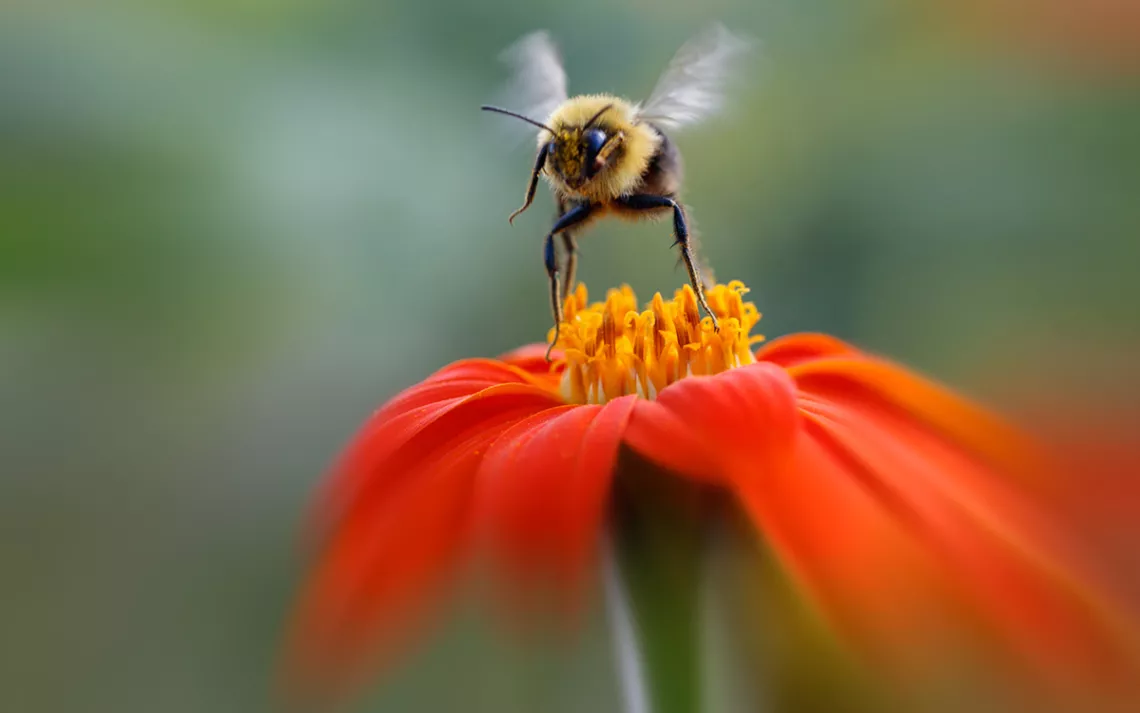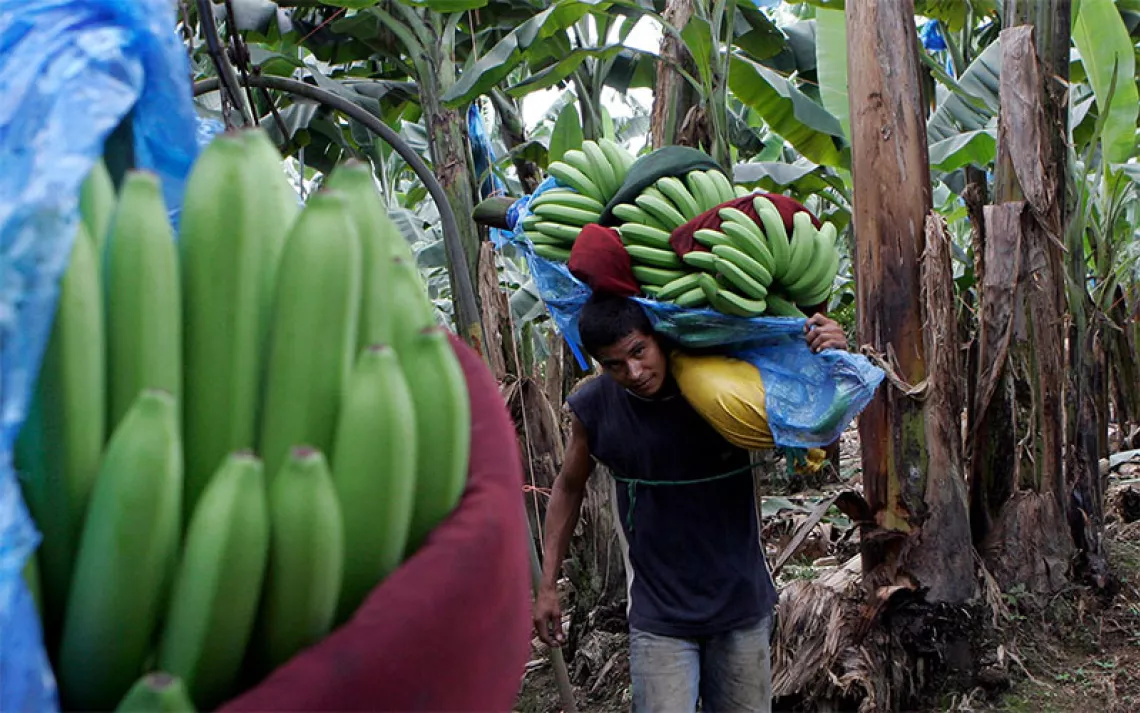Is the EPA Helping to Poison Bees?
A controversial rule pits pollinator advocates against farmers

Photo by Jean Landry | iStock
The EPA has been allowing growers to spray pesticides that are toxic to honeybees and other pollinators using a loophole that bypasses standard environmental review and public comment, according to a report by the Center for Biological Diversity (CBD), an environmental legal advocacy group.
The CBD analyzed EPA records and found 78 instances since 2012 when the agency permitted sulfoxaflor, a compound that the EPA’s own research found highly toxic to pollinators, to be used on crops spanning an area of over 17.5 million acres in 18 states. The EPA justified this, says the CBD, by using a loophole in its own regulations that allows for “emergency exemptions” in cases involving “an urgent, nonroutine situation that requires the use of a pesticide(s).”
Sulfoxaflor was initially developed by Dow Chemical in 2010 and was marketed as a safer alternative to neonicotinoids, a widely used class of pesticide. Neonicotinoids had become a prime suspect in colony collapse disorder, to the point where they had been banned in some countries for their toxicity to honeybees.
Sulfoxaflor was approved by the EPA in 2013, but in 2015, the 9th Circuit Court reversed that approval after a lawsuit brought by the American Beekeeping Association and other bee-related organizations argued that the approval was made using flawed and limited data, and that sulfoxaflor showed signs of being dangerous to bees. Dow was allowed to amend its application for approval, which it did. The new application said, among other things, that sulfoxaflor could be applied while crops weren’t in bloom to avoid pollinators, and only while wind speed was sufficiently low to keep the pesticide from drifting into areas foraged by bees. In 2016, the EPA approved its use under those circumstances.
But growers can still use sulfoxaflor in ways that sidestep those restrictions. The EPA’s Section 18 allows for something called “emergency exemptions” for pesticides. Section 18 is meant to control unexpected outbreaks of pests that are resistant to approved methods, like an unusual boom in invasive bugs or a fungus. But according to the Center for Biological Diversity report, the EPA has granted emergency exemptions for sulfoxaflor for use against pests that have been plaguing crops for years, like aphids and tarnished plant bugs.
Permitting routine exemptions, says the CBD report, allows pesticide manufacturers to bypass the lengthy approval process put in place to safeguard public and environmental health. “Spraying 16 million acres of bee-attractive crops with a bee-killing pesticide in a time of global insect decline is beyond the pale, even for the Trump administration,” says Nathan Donley, a senior scientist at CBD in a statement. “The EPA is routinely misusing the ‘emergency’ process to get sulfoxaflor approved because it’s too toxic to make it through normal pesticide reviews.” Last fall, the EPA’s own research found that while the “emergency exemption process provides flexibility to growers and other pesticide applicators during emergency situations,” it was less good at measuring “how well the emergency exemption process maintains human health and environmental safeguards.”
And the use of sulfoxaflor seems to be on the rise. Last year, Dow entered an application to the EPA to expand sulfoxaflor’s emergency exemption from cotton and sorghum to avocados, rice, tree farms, ornamental plants, and other crops.
Some disagree with the CBD’s assessment that the EPA’s emergency exemption program is too permissive for sulfoxaflor. Professor David Kerns, the Statewide Integrated Pest Management Coordinator for Texas A&M University, has worked extensively with cotton and sorghum and has been involved in Section 18 registrations for sulfoxaflor. When pesticides like organophosphates were delisted, says Kerns, growers were left with few options for controlling increasingly resistant outbreaks of tarnished plant bugs in cotton and sugar aphids in sorghum. “The emergency came with tarnished plant bugs because resistance was so widespread to other products that we had nothing else,” says Kerns. “But since we've gotten the Section 18, and since you've seen it used for several years in a row now, the benefits of that product in the system are paying off.” Kerns says that sulfaxoflor’s effectiveness has actually reduced the overall amount of chemicals sprayed—in that regard, he said, it’s ”an environmental win” in cotton.
Pollinator warnings on products containing sulfoxaflor tell growers to avoid spraying when pollinators are present, though no regulatory mechanism ensures that sprayers follow such warnings. “The vast majority of cotton and sorghum farmers are using sulfoxaflor responsibly,” says Kerns. “If sulfoxaflor use was shown to be causing bee kills and hive decline, then we would no longer support the Section 18.”
“Once the product is dry, its toxicity to bees is greatly reduced. It is highly toxic to bees as wet droplets,” he added. “The goal is to not treat fields with bees actively foraging.”
According to an Entomological Society of America study, sulfoxaflor shows little negative impacts on other beneficial insects—in this case, predatory insects that eat aphid pests in soybeans. But a 2018 study in Nature found that bumblebee colonies exposed to sulfoxaflor reproduced in far lower numbers than colonies that had not.
The relationship between farmers and pollinators raises some underlying challenges built deeply into the industrial farming system. Large monocultures have created real challenges for bees, because without a diverse range of plants and nutrients, they are more susceptible to diseases and parasitism. Some states have pollinator protection plans that seek to further minimize the risks that pesticides create, but how pesticides impact native pollinators like bumblebees remain difficult to quantify, since they often live alone, rather than in hives, and lack beekeepers to monitor their well-being.
Pesticides can also make bee problems much worse. “If you're exposed to pesticides and you have poor nutrition, it's much much worse than just having poor nutrition, or just having pesticides alone,” says James Nieh, an entomologist at UC San Diego. “There's this multiplicative factor called a ‘synergy’ that occurs.” But often, other chemicals wear on bee health in unforeseen ways. Glysophate, the primary ingredient in Roundup, appears to damage bee microbiomes. And various fungicides like Signum and Rovral have been shown to have negative synergistic effects on honeybees and wild bees, inhibiting their ability to digest food and flush toxins out of their cells.
Reed Johnson, an entomologist who studies pesticides and bees at Ohio State University, sees some merits of emergency exemptions—but only if they’re used for actual emergencies. “An emergency exemption is meant for some emerging problem where the agricultural sector needs a solution sooner than the wheels of the registration process can deliver that solution,” says Johnson, who once helped beekeepers apply for Section 18. In that case, they wanted to spray bee colonies for varroa mite outbreaks with Hopguard, a potassium salt bi-product of beer production, that wouldn’t pass the normal Section 3 approval process in time to be effective. In this case, Johnson says, Section 18 was invaluable.
Emergency is in the eye of the beholder. Cotton—which is not a food crop—consumes 14 percent of all insecticides and makes a frequent appearance on the EPA’s emergency exemption list for sulfoxaflor. The more pesticides like sulfoxaflor and neonicotinoids are used, the more likely it is that target pests will eventually become resistant. A study of 1,000 farms in France published in the peer-reviewed journal Nature Plants found that slashing pesticide use would not bring drops in crop production. The UN Human Rights Council has disputed the theory maintained by chemical companies that without pesticide inputs, a booming global population would go unfed.
Ideally, pesticides would be a last resort in a greater pest control strategy. “Integrated pest management (IPM) is, in my opinion, the crowning jewel of the field of entomology,” says Johnson. Farms who adopt IPM use a range of management tools—things like biological controls, hardier crop strains, and added habitat for beneficial insects—to keep pests below the threshold of causing farmers economic damage. That doesn’t necessarily mean the end of chemical inputs. Rather, when the other controls fail to stem serious losses, pesticides can be a final resort.
Kerns agrees that protecting pollinators should be a high priority for growers. “My colleagues and I all stress adopting IPM practices which are principally built around preventing pest problems using a variety of cultural and biological factors, using pesticides only when needed, and if using pesticides, to choose one that pose minimal risk to nontarget insects, the environment and human health,” says Kerns. “Unfortunately, there are times when pesticides are necessary.”
But many cotton and sorghum growers in his area already have adopted IPM, if for none other than one simple reason: economics. “If you spray all the time,” says Kerns, “you're going to go broke.”
“There’s lots of good reasons for people to try to reach for the pesticide last,” says Johnson. “It will delay resistance to these pesticides. It will reduce the ecological harm that the pesticide use will inevitably have. And in many cases, it's cheaper too.”
 The Magazine of The Sierra Club
The Magazine of The Sierra Club







